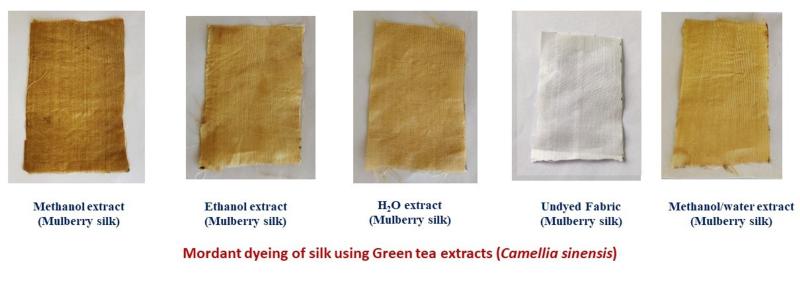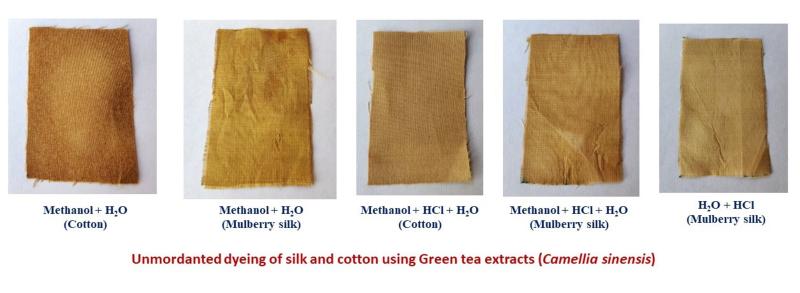Beyond aromatic cups of tea, scientists from India have embarked on a quest to unlock the hidden potential of tea leaves as a possible source of vibrant natural dyes for textiles.
Researchers from the Assam state of India, which is known the world over for its tea and silk, have found that mulberry silk fabrics dyed with green tea extract exhibit a diverse range of color variations. This indicates a promising potential for green tea extract for natural dyes in the textile industry. The research was published in the Industrial Crops and Products journal.
"The primary objective of our research is to elucidate the extraction of tea components from tea leaves, with the aim of facilitating the dyeing process for mulberry silk fabric through mordant-based techniques,” said Dr. Parikshit Gogoi, assistant professor of chemistry and supervisor of the research group at Nowgong College (Autonomous) Assam. He’s currently serving as a Fulbright-Nehru Academic and Professional Excellence Fellow at the Illinois Sustainable Technology Centre, University of Illinois at Urbana-Champaign, United States.

“Notably, the mordant-dyed silk fabric demonstrated excellent color fastness against washing, drying and rubbing, in addition to exhibiting antibacterial activity against Staphylococcus epidermis and UV protection properties,” said Gogoi.
Other research members who shaped the work for publication – with their expertise in the field of interdisciplinary chemical sciences – include Shristirupa Bora, Priyanga Manjuri Bhuyan, Balin Kumar Bhuyan, Barnali Sarma, Swapnali Hazarika and Aniruddha Gogoi.
Mordant silk dyeing is a textile dyeing technique that involves the use of mordants to fix or set the dye on silk fabric. Mordants are substances that form a chemical bond between the dye and the fiber, enhancing the colorfastness and permanence of the dye on the fabric. This process is commonly used in natural dyeing to ensure that the color adheres to the textile fibers effectively.
"The northeastern region, particularly Assam, is well-known for its extensive tea cultivation, contributing significantly to India's overall tea production as a vital industrial crop,” said Gogoi. “The utilization of tea leaves beyond beverage production has emerged as a pressing concern within the scientific community, primarily driven by its economic potential.”
Tea leaves are rich in various bioactive compounds, including predominant catechins, as well as minor quantities of flavanols, such as kaempferol, rutin, quercetin and phenolic acids. Catechins in green tea, a semi fermented tea, possesses potent antioxidant properties and exhibit strong antimicrobial effects against bacteria and fungi. “Consequently, green tea extracts are being proposed as an ideal choice for silk dyeing, owing to the advantages associated with natural dyes,” Gogoi explained.
Mulberry silk variety is characterized by its white or off-white color and holds a significant cultural importance as the traditional attire of the region.
The ability of dyed fabric to maintain the color shade on washing and rubbing or exposure to other physical and chemical conditions is referred to as fastness properties of dyed fabric. The mordant dyed silk fabric showed excellent color strength during the research. The color strength is a measurement used in color science and colorimetry to quantify the strength or intensity of color in a material, often in the context of textiles, dyes, or pigments.
“Dyeing silk with polyphenols added UV protective capacity to the undyed one, which had nominal activities,” shared Gogoi. “The transmittance rates of the undyed silk fabric in Ultraviolet A and Ultraviolet B were 33.18 percent and 20.39 percent, respectively, with an Ultraviolet Protection Factor [UPF] value of 6.84. The dyed silk samples with higher UPF values and lower transmittance rates indicate better protection levels. Both UV-A and UV-B radiation are components of sunlight, and excessive exposure to either can have adverse effects on human health, including skin damage and an increased risk of skin cancer.”
A Shift Towards Natural Dyes
“The impetus for this endeavor arises from the growing global interest in harnessing industrial crops for the creation of novel color shades, replacing environmentally harmful synthetic dyes,” Gogoi said. “In the competitive landscape of the manufacturing sector, the global textile industry is thriving, with an anticipated annual compound growth rate of 4.4 percent during the current decade.”
Despite the predominance of has encouraged the utilization of natural dyes in various sectors such as food, textiles, medicine and agriculture. This shift towards natural dyes is driven by sustainability and eco-safety considerations. Furthermore, natural dye components, such as polyphenolics, anthraquinones, flavonoids and anthocyanins, offer additional advantages to colored fibers, including UV protection, antioxidant properties, antimicrobial effects and flame retardancy.

Revolutionizing the Textile Industry
The research highlights the feasibility of developing sustainable dyeing methods derived from tea, a renewable source. “This approach not only holds promise for the textile industry but also has the potential to create employment opportunities and generate income for individuals in rural and suburban areas, through tea farming and waste utilization," Gogoi said. "Furthermore, this investigation serves as a catalyst for future research endeavors, encouraging the development of greener dyeing methodologies applicable to silk, cotton and various other fabrics, with potential applications in the fields of medicine and energy."
He added: “This innovation, leveraging the most widely consumed beverage globally, after water, has the potential to revolutionize the textile industry. Notably, it boasts numerous merits, including its natural and eco-friendly composition, non-toxic nature, provision of UV protection, antimicrobial properties, and, importantly, aesthetic appeal.”
Furthermore, it has been suggested that the escalating awareness surrounding eco-friendly and sustainable products may generate a heightened demand for textiles dyed using natural sources like green tea extracts.
“Countries that produce both silk and tea, such as India, China, Japan, South Korea and Brazil, stand to benefit significantly from these sustainable resources as a means to foster economic growth," revealed Gogoi. "Preliminary experiments have yielded positive results for cotton coloration, and future include scaling up these applications, contingent on the availability of funding."
The primary author of the published study, Shristirupa Bora, currently enrolled in a Ph.D. program, said the silk coloration process can be easily executed under standard laboratory conditions and without the necessity of expensive equipment or chemicals. “This underscores the practicality and accessibility of the method,” she pointed out.
Bora noted that while the optimization of the extraction and dyeing procedures may require some time, the process itself can potentially be undertaken by individuals without extensive chemistry knowledge. “This suggests the prospect of extending the application of this process to regions engaged in silk cultivation,” she said.
Roopak Goswami has worked for more than two decades as a newspaper journalist in Northeast India. Tea is his passion, and he covers the global tea industry regularly for World Tea News.
Don’t Miss the Weekly World Tea News eNewsletter! Get your free subscription, if you’re not already subscribed, by clicking here.
Plan to Attend or Participate in World Tea Expo, March 18-20, 2024
To learn about other key developments, trends, issues, hot topics and products within the global tea community, plan to attend World Tea Expo, March 18-20, 2024 in Las Vegas, co-located with Bar & Restaurant Expo. Visit WorldTeaExpo.com.
To book your sponsorship or exhibit space at the World Tea Conference + Expo, or to enquire about advertising and sponsorship opportunities at World Tea News, contact:
Ellainy Karaboitis-Christopoulos
Business Development Manager, Questex
Phone: +1-212-895-8493
Email: [email protected]
Also, be sure to stay connected with World Tea Expo on social media for details and insights about the event. Follow us on Twitter, Facebook, Instagram and LinkedIn.
